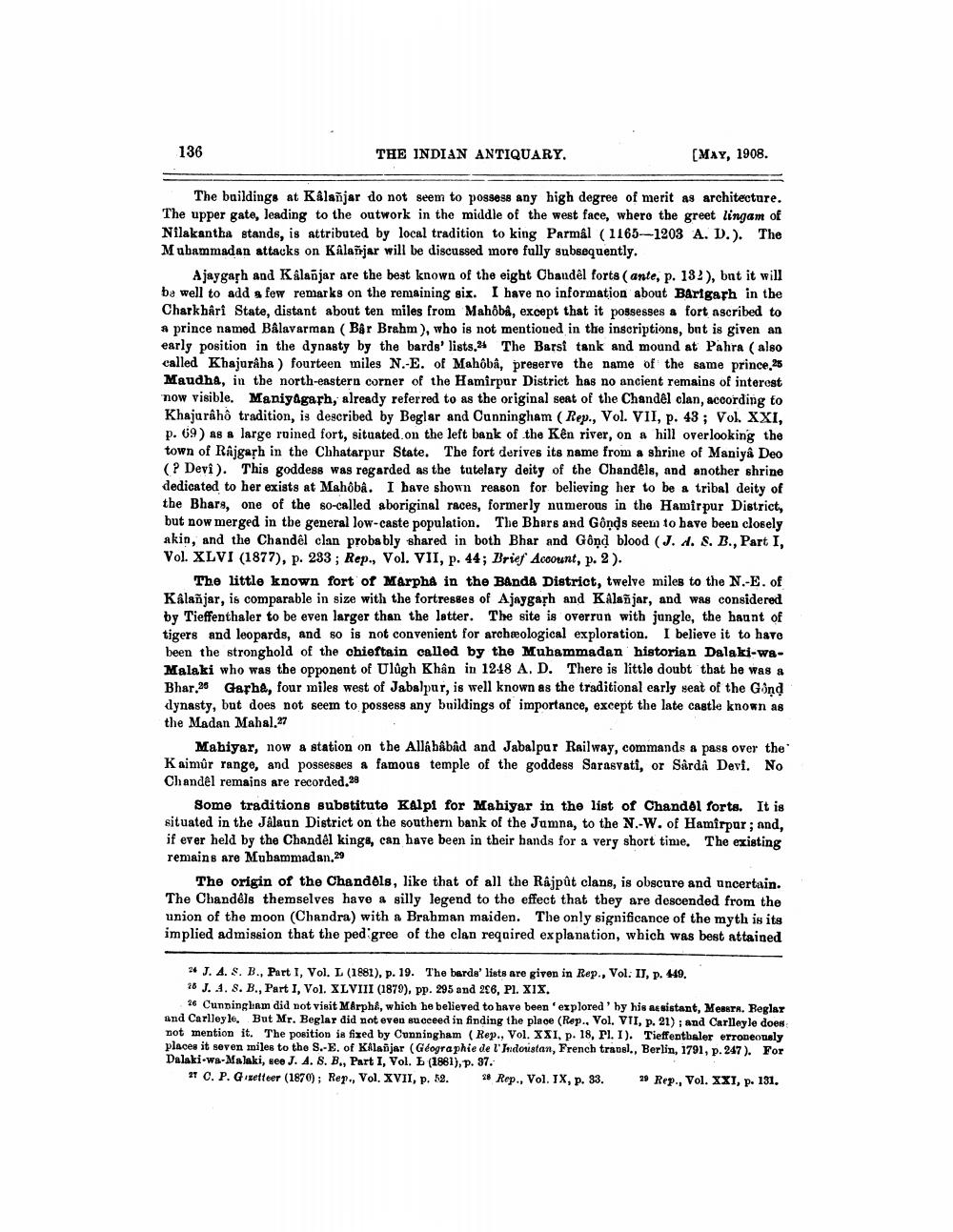________________
136
THE INDIAN ANTIQUARY.
(MAY, 1908.
The buildings at Kalañjar do not seem to possess any high degree of merit as architecture. The upper gate, leading to the outwork in the middle of the west face, where the greet lingam of Nilakantha stands, is attributed by local tradition to king Parmál ( 1165-1203 A. D.). The Mubammadan attacks on Kalañjar will be discussed more fully subsequently.
Ajaygarh and Kalanjar are the best known of the eight Chandel forts ( ante, p. 132), but it will ba well to add a few remarks on the remaining six. I have no information about Barigarh in the Charkhåri State, distant about ten miles from Mahôbê, except that it possesses a fort ascribed to a prince named Balavarman (Bar Brahm), who is not mentioned in the inscriptions, but is given an early position in the dynasty by the bards' lists.24 The Barsi tank and mound at Pahra ( also called Khajuraha) fourteen miles N.-E. of Mahobâ, preserve the name of the same prince.25 Maudha, in the north-eastern corner of the Hamirpur District has no ancient remains of interest now visible. Maniyagarh, already referred to as the original seat of the Chandel clan, according to Khajurahồ tradition, is described by Beglar and Cunningham (Rep., Vol. VII, p. 43; Vol. XXI, p. 69) as a large ruined fort, situated on the left bank of the Kên river, on a hill overlooking the town of Rajgarh in the Chhatarpur State. The fort derives its name from a shrine of Maniyâ Deo (? Devi). This goddess was regarded as the tutelary deity of the Chandels, and another shrine dedicated to her exists at Mahoba. I have shown reason for believing her to be a tribal deity of the Bhars, one of the so-called aboriginal races, formerly numerous in the Hamirpur District, but now merged in the general low-caste population. The Bhars and Gônds seem to have been closely akin, and the Chandel clan probably shared in both Bhar and Gônd blood (J. d. S. B., Part I, Vol. XLVI (1877), p. 233; Rep., Vol. VII, p. 44; Brief Acoount, p. 2).
The little known fort of Marpha in the Banda District, twelve miles to the N.-E. of Kalañjar, is comparable in size with the fortresses of Ajaygarh and Alañjar, and was considered by Tieffenthaler to be even larger than the latter. The site is overrun with jungle, the haunt of tigers and leopards, and so is not convenient for archæological exploration. I believe it to have been the stronghold of the chieftain called by the Muhammadan historian Dalaki-waMalaki who was the opponent of Ulugh Khân in 12448 A. D. There is little doubt that he was a Bhar.26 Garhe, four miles west of Jabalpur, is well known as the traditional early seat of the Gönd dynasty, but does not seem to possess any buildings of importance, except the late castle known as the Madan Mahal.27
Mahiyar, now a station on the Allá bâbâd and Jabalpur Railway, commands a pass over the Kaimûr range, and possesses a famous temple of the goddess Sarasvati, or SÅrda Devi. No Chandel remains are recorded.28
Some traditions substitute Kalpi for Mahiyar in the list of Chandel forts. It is situated in the Jalaun District on the southern bank of the Jumna, to the N.-W. of Hamirpur; and, if ever held by the Chandel kings, can have been in their bands for a very short time. The existing remains are Muhammadan.29
The origin of the Chandels, like that of all the Rajpût clans, is obscure and uncertain. The Chandels themselves have a silly legend to the effect that they are descended from the union of the moon (Chandra) with a Brahman maiden. The only significance of the myth is its implied admission that the pedigree of the clan required explanation, which was best attained
24 J. A. S. B., Part I, Vol. L (1881), p. 19. The barda' lists are given in Rep., Vol. II, p. 449. 26 J. 4. 8. B., Part I, Vol. XLVIII (1879), pp. 295 and 286, Pl. XIX.
26 Cunningham did not visit Marpha, which he believed to have been explored 'hy his assistant, Messrs. Reglar and Carlleyle. But Mr. Beglar did not even succeed in finding the place (Rep., Vol. VII, p. 21); and Carlleyle does not mention it. The position in fixed by Cunningham (Rep., Vol. XXI, p. 18, PI. I). Tieffenthaler erroneously places it seven miles to the S.-E. of Kalanjar (Géographie de l'Indonistan, French transl., Berlin, 1791, p. 247). For Dalaki-wa-Malaki, see J. A. 8. B., Part I, Vol. 5 (1861), p. 37.
27 C. P. G xetteer (1870); Rer., Vol. XVII, p. 52. 28 Rep., Vol. IX, p. 33. 29 Rep., Vol. XXI, p. 131.




